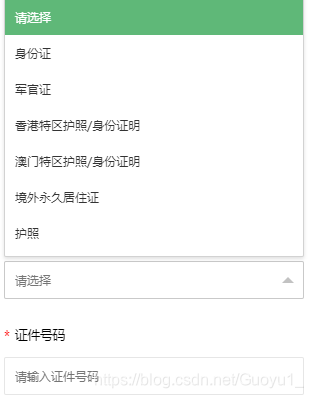js根据不同证件进行校验
本文共 1575 字,大约阅读时间需要 5 分钟。
layui下拉
layui.use(['form','element'], function(){ var form = layui.form ,layer = layui.layer ,id_type;//监听下拉当前选择的 form.on('select(idsType)',function (data) { id_type=data.value }) form.on('submit(demo1)', function(data){ let idVal=$("input[name='idNumber']").val(); let reg; if(id_type==0){ console.log('身份证',id_type) reg = /(^\d{15}$)|(^\d{17}(\d|X|x)$)/; if(!reg.test(idVal)){ layer.msg('证件信息错误', {time: 4000, icon:5}); return false; } }else if(id_type==1){ console.log('军官证',id_type) reg = /^[a-zA-Z0-9]{7,21}$/; if(!reg.test(idVal)){ layer.msg('证件信息错误', {time: 4000, icon:5}); return false; } }else if(id_type==2){ console.log('香港特区护照/身份证明',id_type) reg = /^[a-zA-Z0-9]{5,21}$/; if(!reg.test(idVal)){ layer.msg('证件信息错误', {time: 4000, icon:5}); return false; } }else if(id_type==3){ console.log('澳门特区护照/身份证明',id_type) reg = /^[a-zA-Z0-9]{5,21}$/; if(!reg.test(idVal)){ layer.msg('证件信息错误', {time: 4000, icon:5}); return false; } }else if(id_type==4){ console.log('境外永久居住证',id_type) reg = /^[A-Z]{3}\d{6}(?:0[1-9]|1[021])(?:0[1-9]|[21]\d|3[10])\d{2}$/; if(!reg.test(idVal)){ layer.msg('证件信息错误', {time: 4000, icon:5}); return false; } }else if(id_type==5){ console.log('护照',id_type) reg = /^[a-zA-Z0-9]{3,21}$/; if(!reg.test(idVal)){ layer.msg('证件信息错误', {time: 4000, icon:5}); return false; } }}}) 
转载地址:http://nwkj.baihongyu.com/
你可能感兴趣的文章
nginx报错:the “ssl“ parameter requires ngx_http_ssl_module in usrlocalnginxconfnginx.conf128
查看>>
Nginx搭建RTMP服务器+FFmpeg实现海康威视摄像头预览
查看>>